If you’ve ever asked yourself, why is my fish tank cloudy, and what causes cloudy water in a fish tank, you need to read this guide! That dreaded murky water could be caused by bacterial bloom during the cycle of a new tank, or there may be a more sinister cause. Whatever the reason for the foggy water, you’ll need to know how to fix a cloudy fish tank.
So, here’s everything you need to know!
What Causes Cloudy Water In A Fish Tank?
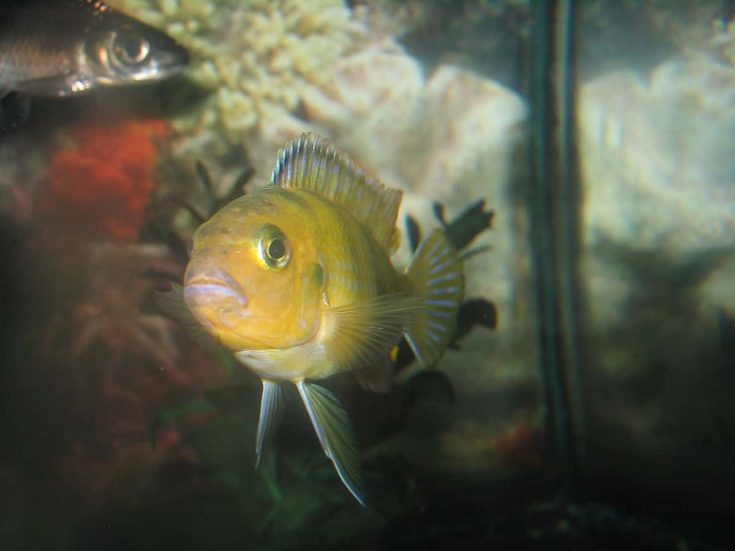
First of all, what color is your water? That may sound like an odd question, but there are actually different shades of murky, and that tells you what’s causing the fogginess, as well as providing you with solutions to the problem.
White/Grayish Water
There are several causes of white or gray water in cloudy fish tanks.
Gravel Residue
If your aquarium water becomes fogged with grayish or white cloudiness the minute you fill a new tank, your problem is almost certainly caused by dust and dirt washing off the new substrate, typically gravel.
The fix for this issue is simple; just empty your tank, remove the gravel, and wash the substrate under running water until the water runs clear.
Dissolved Constituents
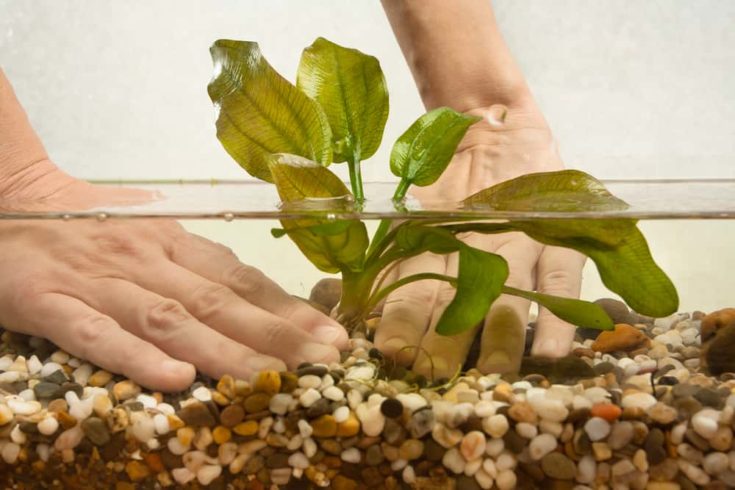
If your substrate is clean, but the water is still murky, the problem is most likely due to high levels of dissolved constituents, including heavy metals, silicates, or phosphates.
Test the tank water using a simple aquarium water testing kit, and you’ll probably discover that the water is very alkaline with a correspondingly high pH level. You can typically solve the problem by dosing the water with a tap water conditioner or pH buffer.
In some regions, it may be that the tap water is causing the issue. You can solve that problem by using Reverse Osmosis (RO) water instead of tap water. Most good fish stores sell RO water, or you might prefer to buy an RO unit, which will be more cost-effective if you have a large tank or more than one setup.
Bacterial Bloom
If you have a new tank and the water turns murky within a few days or a week or so after you set it up, the cloudiness is most likely caused by bacterial bloom.
Bacterial bloom, or bacterial blossom, as the phenomenon is also known, occurs when a new biological filter system is maturing. The problem generally resolves by itself over a couple of weeks or months. Meanwhile, you can help the beneficial bacteria in the biological filter by vacuuming the tank thoroughly at least once each week to remove fish waste, uneaten food, and plant debris.
Sometimes, reducing the amount of food that you give your fish can help to ease the burden on the filter system, clearing the water as a result.
Don’t Turn Off Your Filter System
You can trigger bacterial bloom by switching off your filter system overnight. Ideally, your filter should be running 24/7/365, and you only need to briefly turn it off when you’re maintaining the aquarium, or cleaning or changing the filter media.
How Does Flocculate Help To Clear Cloudy Water?
You can use water additives called flocculates to help clear your water. Flocculates work by causing tiny particles of floating debris to clump together so that the mechanical element of your filtration system can remove them from the water, effectively curing the cloudiness.
You’ll find flocculates for sale in your local fish store, labelled as “water clarifiers.”
Beware Big Water Changes!
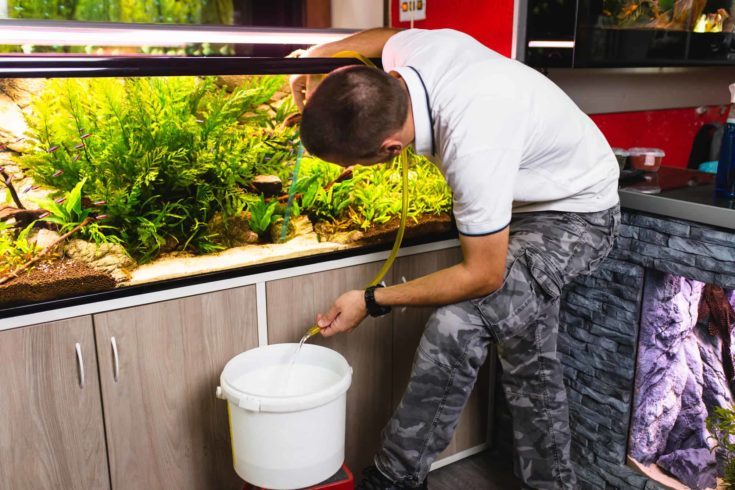
Many hobbyists inadvertently cause bacterial bloom after a big water change that upsets the delicate eco-balance within the aquarium. Removing too much water from your tank can kickstart a mini-cycle, when the beneficial bacterial colonies that live in your tank and in the filter media begin to repopulate.
So, stick to carrying out partial water changes of around 20% to 25% every week, and if you do need to change half the water in your tank for any reason, be sure to add a filter boosting product to the water.
Green Water
Cloudy green water in your fish tank is pretty much certain to be caused by algae growth in the water.
Algae are tiny aquatic organisms that you often find growing everywhere in your fish tank, including on the substrate, glass, decorations, and even on your plants. There are also some species of algae that live in the water, floating around and giving the water a cloudy, greenish tinge.
How To Get Rid Of Algae In Aquarium Water
Getting rid of algae in your fish tank is not easy once it gets established. As algae can be caused by several things, you need to use a multi-pronged attack strategy:
Reduce Excessive Light
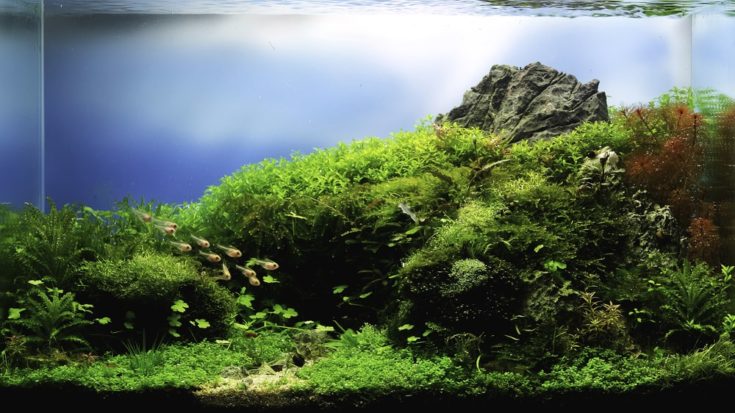
Too much bright light, especially sunlight, can encourage algae to grow in your fish tank water. You can restrict the growth of algae by moving your tank away from sunlight or screening the aquarium with blinds or drapes for the part of the day when the sun is shining on the tank. Also, you need to reduce the hours that your aquarium lights are on, perhaps by using a timer.
Once the algae are starved of light, they will eventually die off, and your filter system will remove the green algae from the water, leaving it clear again.
Phosphates
Phosphates that are derived from decomposing organic waste matter in the water and from the water source itself are effectively plant fertilizers that encourage algae to grow.
To reduce the amount of phosphates in the water, begin by giving the tank a deep clean, including trimming away dead plant matter and vacuuming the substrate to get rid of fish waste and uneaten food.
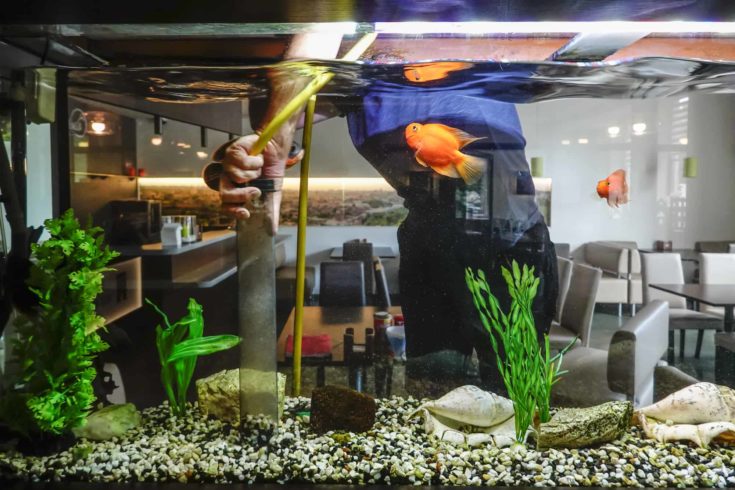
Once that’s done, test your tap water, as that could be the source of the problem. The Safe Drinking Water Act (SDWA) of 1974 dictates that the U.S. Environmental Protection Agency is duty-bound to chemically treat the domestic water supply to make it safe for you to use and drink. That process means that the water is chemically treated, often resulting in high phosphate levels.
If your domestic water supply contains high levels of phosphates, you’ll need to switch to using RO water for your aquarium or chemically treat the water to get rid of the phosphates before putting the water in your fish tank.
Nitrates
Nitrates also act as plant and algae fertilizers.
The levels of nitrates in your fish tank generally rise in direct correlation to the amount of fish waste that’s contained in the water, and, ideally, your aquarium water should not contain more than 20ppm (parts per million) of nitrates. As long as you carry out partial water changes of up to around 30% every week and you maintain your filters properly, nitrate levels should be pretty easy to keep under control.
For the biological element of your filter system to work efficiently and remove nitrates from the water, you need to have a good flow rate throughout the tank. Ideally, you want a GPH (Gallons Per Hour) flow rate of at least four times the total volume of water in your tank, preferably more.
Yellow/Brownish Water
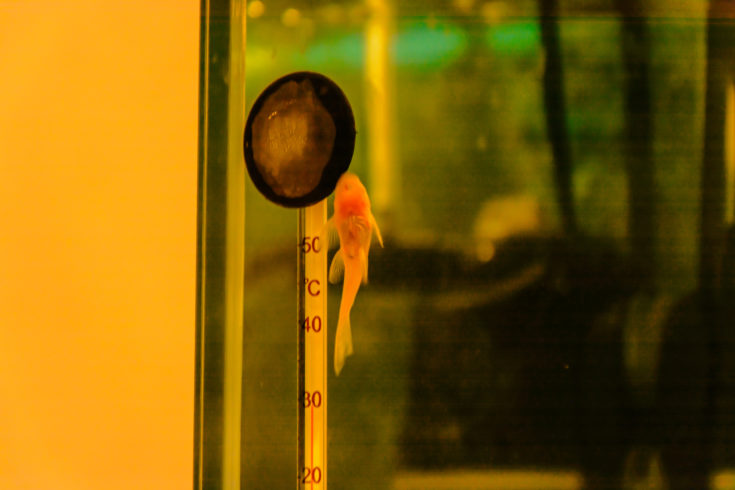
Although it’s quite unusual for fish tank water to turn a murky brown or yellowish color, that can sometimes happen.
Driftwood
Many hobbyists use bogwood and driftwood as aquarium decorations. Wood looks very natural, some plant species can be trained to grow on the wood, fish use the wood to determine territories and use as hiding places, and colonies of beneficial microbes grow on the wood’s surfaces, providing food for fish and fry.
However, the tannins that the wood contains can leach into the water, lowering the pH level slightly, and sometimes turning the water the color of cold tea. Some fish species appreciate a “black water” environment because that mimics their natural habitat, but yellow or brownish cloudy water doesn’t look great and makes the tank look dirty, which in reality it isn’t.
How To Prevent “Black Water” In Your Fish Tank
You can prevent “black water” from forming in your tank by soaking driftwood or bogwood in a bucket for a few days before you put the wood into your aquarium. Of course, any tank decorations that you buy from a pet store should be prepared, so you won’t have that problem. If you have an activated carbon filter, that will help to remove some of the discoloration, too.
Dried Leaves
A layer of dried leaves on the substrate can help to replicate some fish species’ natural environment, giving the tank an Amazonian vibe and providing somewhere for colonies of microbes to grow that can provide food for fish and fry.
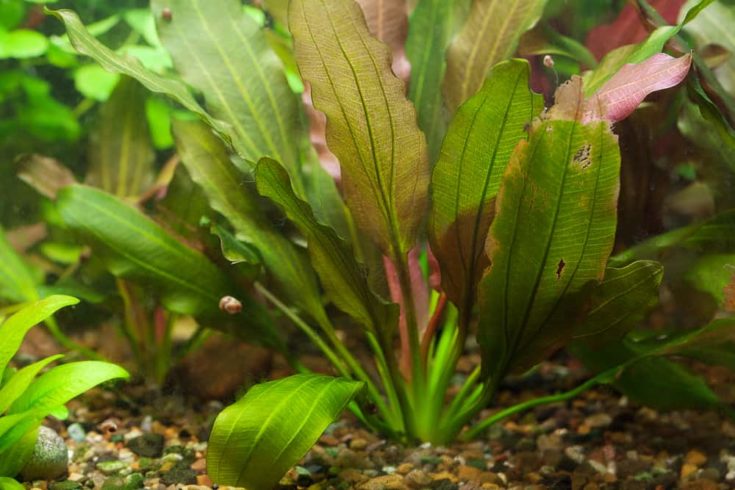
Dried leaves also leach tannins that will turn the water a brownish color. Unless you want to create a “black water” habitat, you’ll need to remove the leaves to allow the water to become clear again.
How To Prevent Cloudy Fish Tank Water
Preventing cloudy fish tank water is pretty straightforward. As well as the fixes mentioned above, there are a few golden rules that you’ll need to follow to keep your aquarium crystal clear.
Avoid Overfeeding
Overfeeding your fish is bad for their health and it will also make the water in your aquarium turn cloudy because of a bacterial bloom or uneaten fish food particles floating in the water.
I recommend that you feed your fish only what they will eat in a couple of minutes. Feed the fish little and often, especially species such as bettas that can suffer from constipation if overfed. It’s also beneficial to have one day each week when you don’t feed your fish at all. That’s not cruel; fasting helps to keep the fishes’ digestive system healthy and prevents associated health problems too.
Avoid Overcrowding

Overstocking your fish tank is asking for trouble on a number of levels. Too many fish crammed together in a small space can cause territorial species to become very aggressive, and a lack of personal space also causes stress, which can also result in health problems and outbreaks of diseases.
Overcrowding an aquarium with too many fish will overload the filter system, overwhelming the beneficial bacteria that process waste products, and leading to bacterial bloom and cloudy water. You can resolve the problem by relocating some of your fish to another tank, carrying out a partial water change, and vacuuming the substrate thoroughly.
Add Activated Carbon Media To The Filter
As previously mentioned, the addition of activated carbon to your filter media can help to remove tannins that may stain the water a brownish yellow color.
Seed The Aquarium
If you have a new setup, you can prevent bacterial bloom and cloudy water by seeding the aquarium.
Seeding involves transferring some substrate, plants, or decorations from a mature tank to the new one. With those items comes beneficial nitrifying bacteria that’s essential for jump starting the tank cycling process. Seeding can cut the usual cycling time by a half, as well as reducing the likelihood of the water becoming cloudy.
In Conclusion
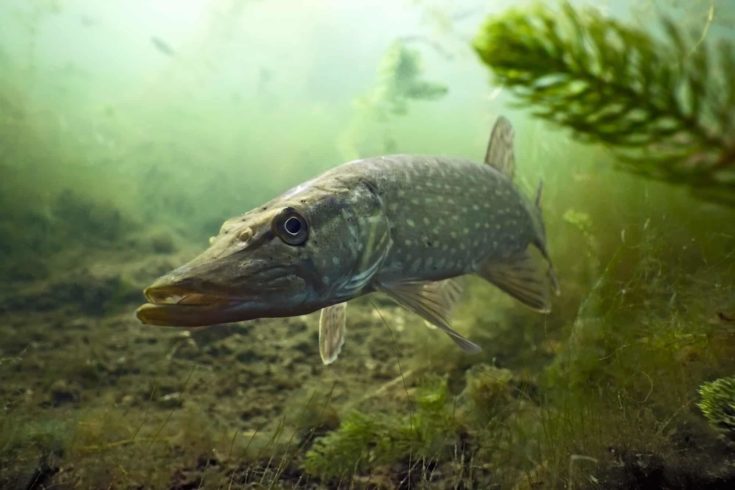
So, if your aquarium water turns cloudy, you’ll need to do some detective work to determine the cause of the problem.
New tanks may turn cloudy because they haven’t cycled fully before fish were introduced, leading to bacterial bloom. If the tank is too brightly lit for too long or exposed to direct sunlight, floating algae may grow, turning the water green. Finally, if you have bogwood, driftwood, or dried leaves in your tank to give it a natural look, you may inadvertently create a black water habitat where the water turns a yellowish brown color because of tannins that have leached into the water.
We hope that you enjoyed our guide to cloudy aquarium water, but if you have any questions, be sure to put them in the comments section below!
Check out our infographic and don’t forget to share!
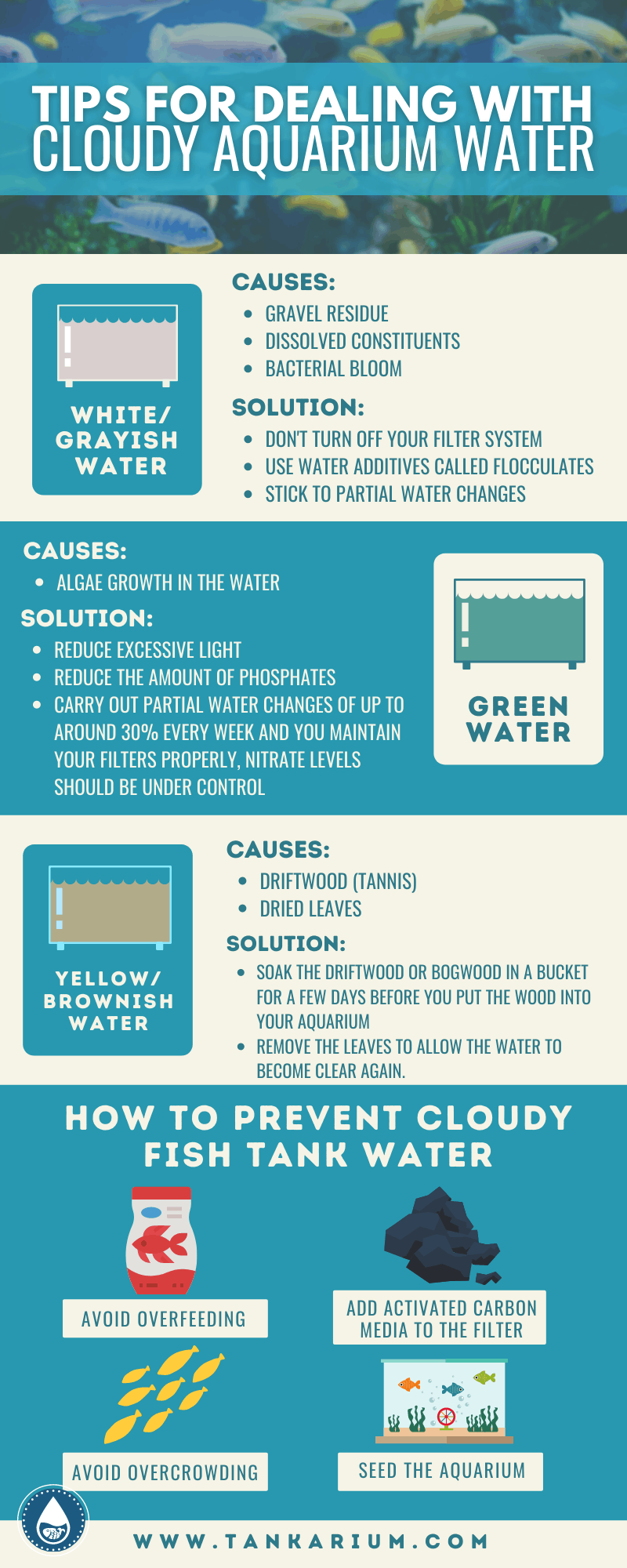

Hi Alison. Great article, you covered the topic very comprehensively. The main causes of cloudy water for me have always been new substrate and bacterial bloom.
I like the natural look of tannins in the water 🙂
Cheers
Follow your guide I can make my tank clean. This will make keeping an aquarium a lot more enjoyable and less of a hassle. Thanks Alison 🙂
Hi Alison. I have a 50 gallon tank with a fresh water community of fish and tank mates ( Cory cats), (snails,frogs). I do regular water changes and tank maintenance to help keep water clear. However I found a great water clarifier I bought and used (Tetra) yellow bottle. I followed instructions on back__ used it one day__ fish water crystal clear the next day. Ms. Feagin
Hi i found your comments very informative and helpful thankyou.